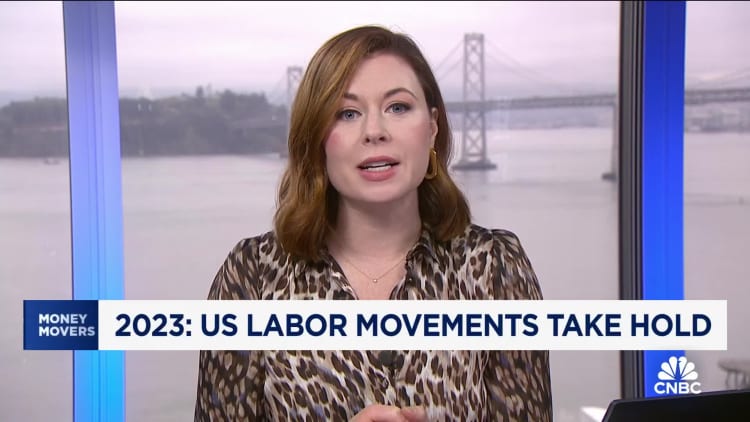Members of the United Auto Workers, or UAW, Local 230 and their supporters walk the picket line in front of the Chrysler Corporate Parts Division in Ontario, California, on Sept. 26, 2023.
Patrick T. Fallon | AFP | Getty Images
The American labor movement flourished in 2023. High-profile strikes by writers and actors against Hollywood brought the union power to the mainstream as pictures of celebrities holding picket signs flooded social media. President Biden made history as the first sitting president to ever appear on a picket line when he visited the United Auto Workers strike in Michigan in September. Successful negotiations between UPS and the Teamsters union led to wide-spread wage increases.
But one big win continues to elude labor: the need to translate its rising popularity into an increase in rank-and-file union membership, which has stagnated in recent decades. This number didn’t budget in 2023.
The latest annual union membership numbers released last week by the Bureau of Labor Statistics reported that the percentage of unionized workers across both the public and private sectors in 2023 remained at 10%. Union members increased by 191,000 to a total of 14.4 million workers, but the share of workers represented by a union — including those whose jobs are covered by a union contract even if they are not members — actually declined from 11.3% to 11.2% of the workforce.
According to Heidi Shierholz, president of the Economic Policy Institute, a pro-union think tank which focuses on policy for lower-income workers, this lack of progress in the numbers seem at odds with the growing prominence of unions on the labor landscape.
It’s not a lack of support from the public that’s holding unions back from making more progress in growing their ranks. Even before the big wins of 2023, polling conducted in recent years showed rising union popularity, with support at its highest level since 1965, according to 2022 data from Gallup.
Union polling has shown similarly positive results, with the AFL-CIO finding that the vast majority of registered voters in America are supportive of both unions and strikes — 71% of individuals polled approve of labor unions, and 75% are in support of workers going on strike.
But according to the Gallup polling, only one in six Americans live in a household with a union member, and its polling, as well as polling by others, shows that nonunion workers remains divided, about fifty-fifty, on interest in joining a union — Gallup’s 2022 polling showed the percentage of nonunion workers who were not interested in membership as high as 58%.
‘The Great Reset’
In 2023, it was a banner year for American workers who support the labor movement.
“I’ve used the term ‘The Great Reset’ to describe what’s happened in collective bargaining in 2023 with the big wage settlements, the threat of strikes, the use of the strike as a source of power,” says Thomas Kochan, a professor at the MIT Sloan School of Management who has been studying the unionization trends for decades. He said the deals reached last year are “way above anything that has been achieved since the early 2000s. So it’s a big year in terms of achievements.”
In 2023, there were 451 strikes, according to the Cornell-ILR Labor Action Tracker, with successes for workers throughout various different sectors of the economy, from SAG-AFTRA and The Writers Guild of America in entertainment, to logistics, healthcare, and hotels and casinos workers across the country also striking successfully.

One reason the membership numbers haven’t seen a bump has to do with the overall size of the labor force. “We’ve had an influx of workers into the labor force, so that labor force is growing as fast or a little bit faster than union membership,” Kochan said.
Where there has been improvement in private sector union membership, Kochan noted that the gains have been concentrated in a few groups of workers: young workers, workers of color, and workers in the high-tech industry.
The numbers clearly show this to be the case. According to EPI analysis of the new data, workers of color accounted for the entire increase in unionization in 2023 — at 309,000 — while membership among white, non-Hispanic workers decreased by 119,000. Union membership among workers under 45 increased by 229,000, while the overall numbers went down among workers age 45 and over.
Battle over labor laws
In recent years, as union issues have gain greater support from the public, labor experts have said a change in the current structure of labor laws would be needed to move the needle on membership. That’s a point they reiterated after the 2023 annual numbers showed another year of stagnation.
“Even though there is this huge popularity of unions, a great deal of interest in them, and rising union activity, we still have just extremely weak labor law that makes it really, really easy for employers, or state lawmakers to really crush union organizing,” Shierholz said.
She described The National Labor Relations Act, the law that governs private sector bargaining, as “incredibly weak, just like breathtakingly weak, in its inability to truly protect worker’s right to organize.”
Punishments of an employer for violating the law are minimal, and public sector employees face barriers to union formation from state and local governments.
“Recent years have seen growing policies to crush state and local government unions,” she said.
According to the BLS data, 31 states and the District of Columbia had union membership rates below the national average of 10% — 11 states had union membership rates below 5%, with South Carolina at the bottom (2.3%). And the numbers are not spread evenly where unions are present in high numbers. According to the BLS, about 29% of the 14.4 million union members lived in California and New York.
Shierholz pointed to tactics like disallowing members to pay union dues through a payroll deduction, which increases the administrative burden on unions, as well as restrictive state and local policy on what’s allowed to be included in negotiations, including wage increase provisions not linked to inflation.
“All these things to try to break down any strength a union has,” Shierholz said. “There’s been a growing number of states that are doing those things, and that played a massive role in the numbers in 2023.”
Kochan says while it’s possible there will be an increase in union membership numbers in 2024 that represents a lag effect from the success and prominence of unions and strikes in 2023, it is simply too soon to tell. But he points to demand for more unionization opportunities that are real.
“We have done a lot of research to see how non-union workers would vote, if they were given an opportunity to choose whether or not to be unionized, and those numbers have gone up considerably,” Kochan said.
“Before the turn of the century, about a third of the non-union workforce would say they would vote for a union, if given the chance. Now that number is 50%,” he said.
The hurdles to getting those workers organized remain considerable, but he said, “that’s 60 million American workers who would gain representation.”
Kochan, too, said progress on labor laws will determine the future. “The demand is there. Whether it can be satisfied under our existing labor laws is the big question and challenge.”
Read More: World News | Entertainment News | Celeb News
CNBC









